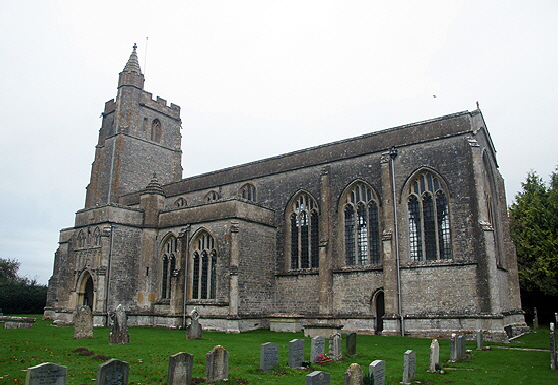|
|
||||||||||||||||||||||||||||||||||||||||||||||||||||||||||
|
Please sign my Guestbook and leave feedback |
||||||||||||||||||||||||||||||||||||||||||||||||||||||||||
|
Recent Additions |
||||||||||||||||||||||||||||||||||||||||||||||||||||||||||
|
|
||||||||||||||||||||||||||
|
Unchanged since it was built, this church is something of a reproach to the almost industrial uniformity of some Perpendicular style buildings. If this church were the work of a Victorian architect we would be decrying the lack of style and imagination. The porches, however, are something of a fig leaf for Lady Elizabeth and her masons. They, at least, do have a modicum of swagger to them. This was 1423, however, and the main purpose of this church was undoubtedly to usher the de Botreaux family rapidly through the wastelands of Purgatory to the the bright uplands of Paradise. We have to concede also that the church was probably seen as something of a wonder in its time and place. So modern, darling! So spacious! It was the minimalism of its day. Inside all is simplicity and, indeed, of elegant and soaring lines. The arcade is lofty, its arches almost feminine in their delicacy. The chancel, its roof as high as the clerestoried nave was surely decided to create awe. It is light: with such huge windows how could it be otherwise. But is also austere. Architecturally, then, it is to be admired rather than to be enjoyed. The enjoyment is engendered not by the building but by its bench ends. They are dated to 1538 so they post-date the building by more than a century. It is almost as if the carpenter rocked up, had a good look around him and then decided to cock a snook at the whole pompous edifice. Somerset is known for its traditions in enjoyable bench ends - see Brent Knoll, East Brent and Stogursey - nor is there the barefaced cheek of many a misericord carving, but North Cadbury’s bench ends are a wonderful insight into late mediaeval life. In particular they show what are surely “real” people wearing “real” clothes. There are literally dozens of them - a dazzling and perfectly preserved entertainment that you must not miss if you are in the area. |
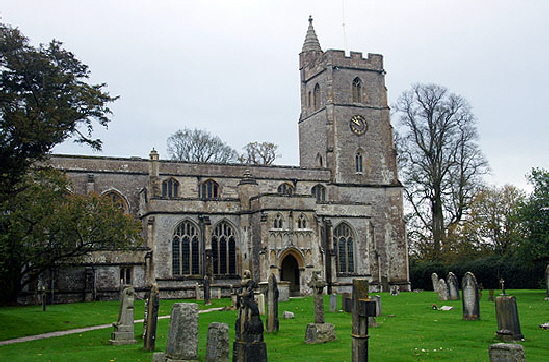 |
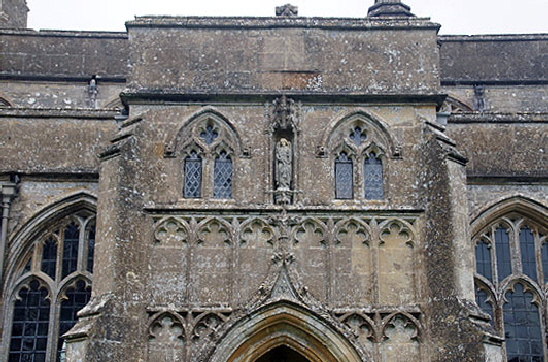 |
||||
|
Left: The church from the north. As you can see, it is a mirror image of the south (picture above). Apart from the very limited effects of weathering, this is pretty much the church that Lady Elizabeth had built next door to her house. Right: I wasn’t sure whether this is the north or the south porch but on this church it really doesn’t matter! In fact it is the north side because the one thing that is different between the north and south sides is the statues in the niches. This one appears to be the north side - see pictures below. The tower at East Brent in Somerset has several filled niches. It does seem that the iconoclasm of the Reformation and the Commonwealth was much less fanatical in the West Country than in, say, the Puritanical East Anglia. |
|||||
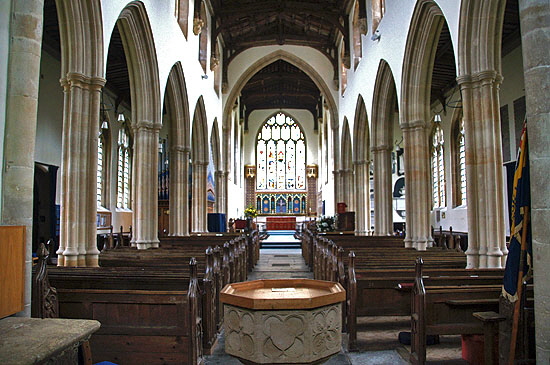 |
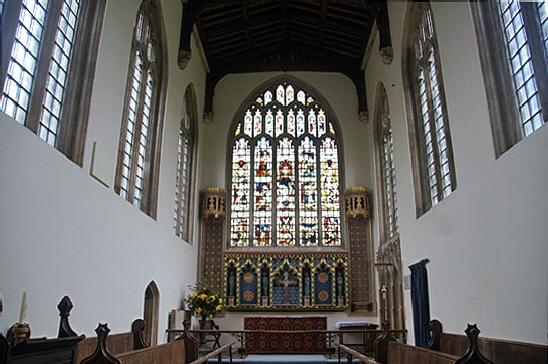 |
||||
|
Left: Looking towards the east. Note the identical and elegant aisle arcades. Right: The chancel is of impressive length and height. It is pretty well as long as the nave with three large windows to each side as well as the large east window. You can see choir stalls on either side. This was a church designed for much more than parish use. |
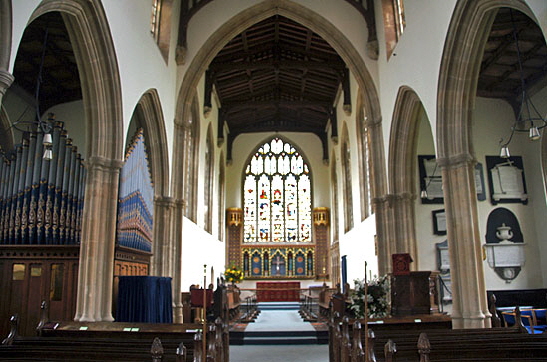 |
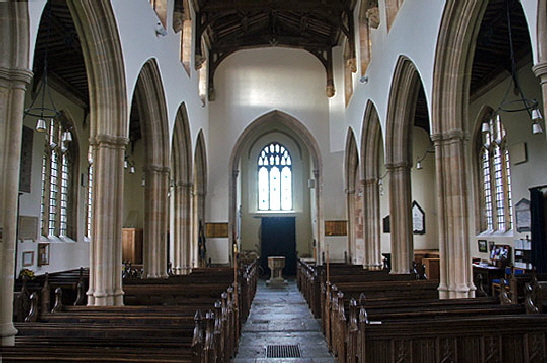 |
|||||||||||||||
|
Left: This picture perhaps gives a better perspective on the length of the chancel. Right: Looking towards the west. Although the tower is a little older than the rest the tower arch and the west window were clearly part of the reconstruction. |
||||||||||||||||
 |
||||||||||||||||
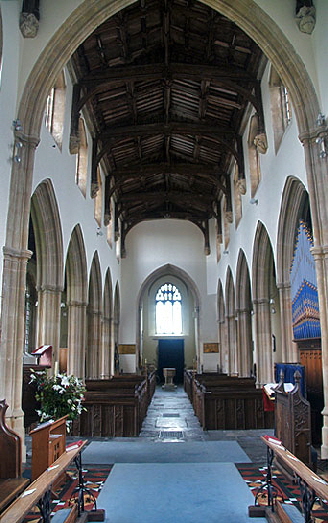 |
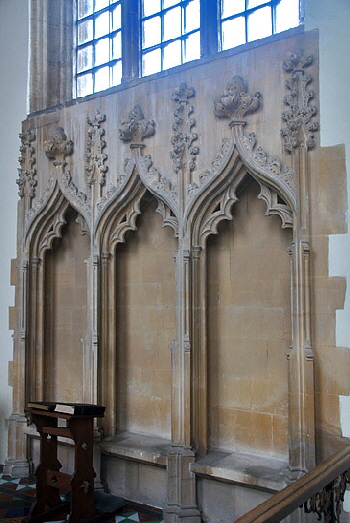 |
 |
||||||||||||||
|
Left: Looking to the west through the chancel arch. Whatever was here before, the parishioners must have been awestruck by their new church. Second Left: The triple sedilia in the chancel. Second Right: The statue in the north porch niche. This appears to be the Archangel Gabriel who was traditionally portrayed a lily (because of his association with the Virgin Mary) or a trumpet (as he will blow the trumpet to announce the Last Judgement. Far Right: The south porch statue is the sword-holding Archangel Michael to whom the church is dedicated. |
||||||||||||||||
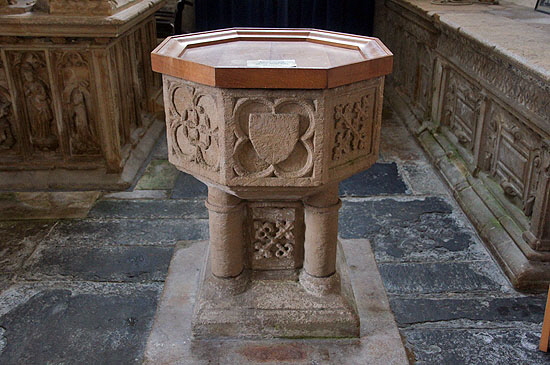 |
||||||||||||||||
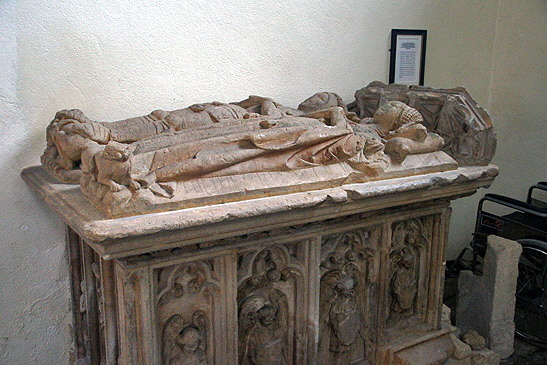 |
||||||||||||||||
|
Left: The octagonal font which, like most of this church, is excellent but rather dull. Right: The tomb of William de Botreaux (d 1391) and Countess Elizabeth (d.1433) who built this church. |
||||||||||||||||
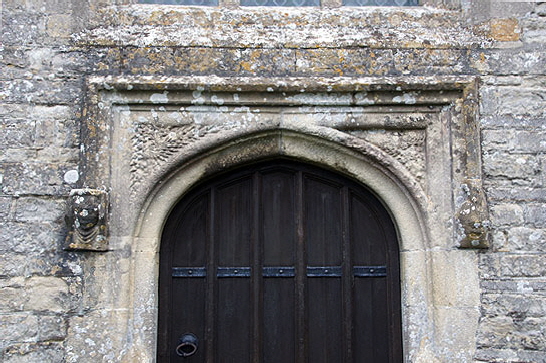 |
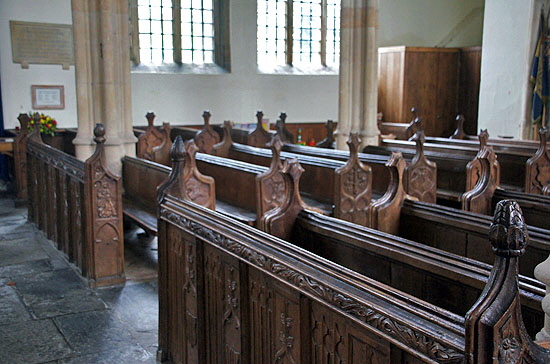 |
|||||||||||||||
|
Left: This is the door at the west end of the church. Note particularly the label stop on the left with a “square” headdress. This form of women’s headwear is not common on churches outside the East Midlands area where I found dozens of examples that allowed me to approximately date the work of the masons I discuss in my book Demon Carvers and Mooning Men. As this church is accurately dated to 1423 this example helps to the validity of that dating. Is this, by the way, meant to be an image of Lady Elizabeth, bearing in mind that her effigy would not have been inside the church until after her death (of course!)? Also bearing in mind that there is very other little external decoration apart from a few gargoyles. Right: Looking across the chancel and aisles we see the carved bench ends and poppy heads. |
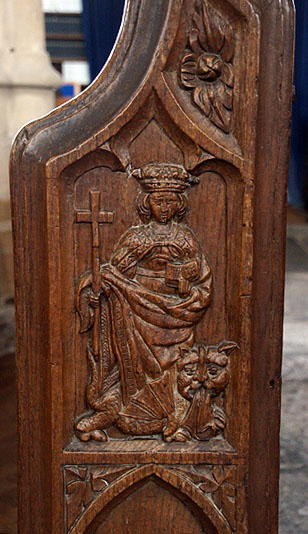 |
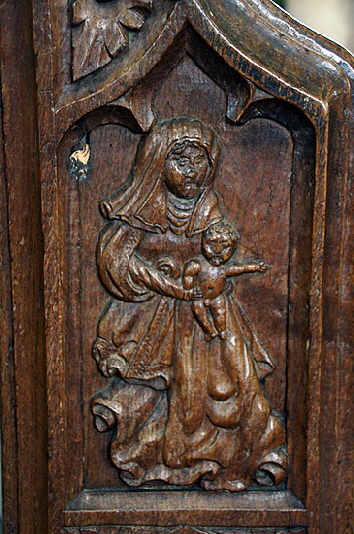 |
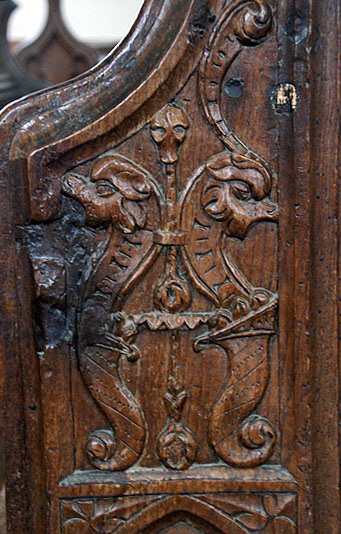 |
||||||||||||||||||||||||||||||
|
Left: This is clearly St Margaret of Antioch as she is always represented with a dragon beneath her feet. Already we are into surprises: if these bench ends were carved in 1538 - right in the middle of the Dissolution of the Monasteries - it is a surprisingly daring piece of work. Centre: This is widely believed to be “Madonna and Child”. I’m afraid I don’t buy that, This is not the adoring mother and holy child imagery we might have expected. Neither figure has a halo - surely inconceivable for an image of Christ? “Mary’s” clothes look quite rich. If this is indeed a Mary and Jesus image then I submit that it has been carved in a way that is deliberately deniable. Right: This is possibly an amphisbaena - a double headed snake featured in the Bestiaries.. On the whole, though, I think that’s really just speculation. |
||||||||||||||||||||||||||||||||
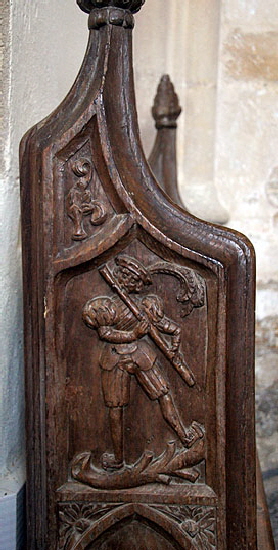 |
||||||||||||||||||||||||||||||||
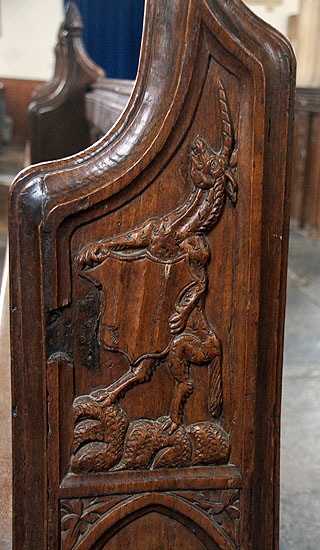 |
 |
|||||||||||||||||||||||||||||||
|
Left: This is one of my favourites. A man plays a flute of somewhat improbable length whilst standing precariously on a log. His costume is beautifully Tudor with slashed britches and tunic and that wonderful plume in his hat. Quelle poseur! Centre: A unicorn holding a shield. Right: Possibly a wyvern. |
||||||||||||||||||||||||||||||||
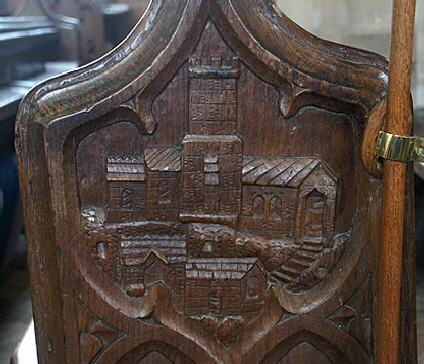 |
||||||||||||||||||||||||||||||||
 |
||||||||||||||||||||||||||||||||
|
Left: A very elaborate carving of a windmill. Note the millstone bottom right. Right: An improbably elaborate carving of a church. It has an axial tower but no transepts. Both the chancel and choir to the left have Norman style windows while the nave window is rectangular Gothic. A stair leads to a west door and the church clearly stands on a hill. Most churches by now would have had west towers, central towers being very much a Norman artifice. So this is no “typical church” and I suggest that it is likely the carver was representing a church that he personally knew. |
||||||||||||||||||||||||||||||||
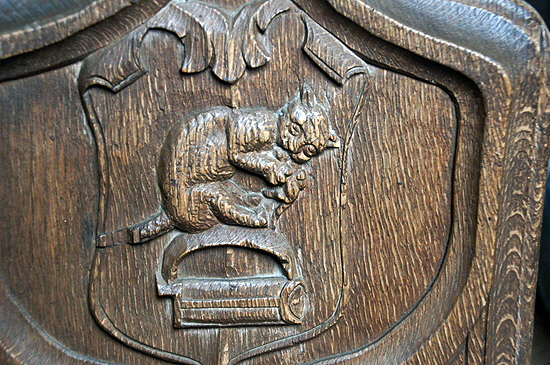 |
 |
|||||||||||||||||||||||||||||||
|
Left: A cat sits atop a mouse trap whilst eating its intended victim. Right: Improbably, these appear to be two snails Or are they little dragons hatching from eggs? They have smirks on their faces! |
||||||||||||||||||||||||||||||||
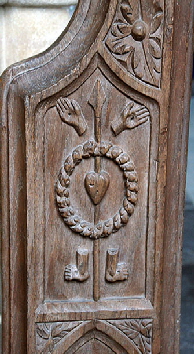 |
||||||||||||||||||||||||||||||||
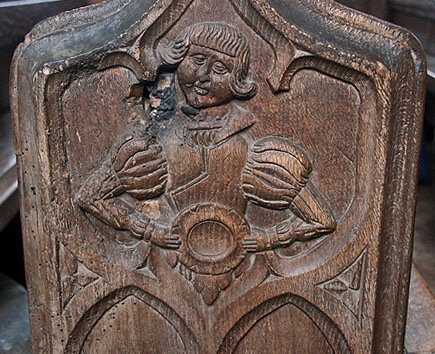 |
||||||||||||||||||||||||||||||||
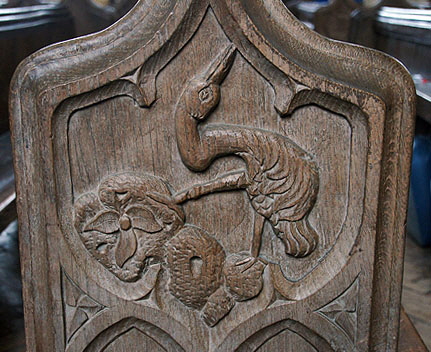 |
||||||||||||||||||||||||||||||||
|
Left: This looks most like a stork and some websites claim it is just that. At the time of writing (2018) there is only one breeding pair of storks In Britain and this is the first recorded pair since 1416. So is it likely that a carver (a common carpenter in all probability) was putting one on a choir stall in 1538 so I always found that totally implausible. Then in 2019 I was contacted by Daniel Barratt from Essex who says: “The bench-end showing a 'stork' is in fact a Common Crane (Grus grus), its actually extremely well carved and shows the carver was very familiar with the species. At the time of building Cranes were breeding in the Somerset Levels, and elsewhere. The carving shows a bird in breeding display posture with neck bent and head thrown back. It also shows the distinctive 'bustle' at the bird's rear which is another feature of breeding plumage. Finally the carver has correctly shown the long falcate feathers just forward of the bustle. All in all a fine carving. My thanks to Daniel for that definitive information. Centre: A bloke holding a hat! Right: The five wounds of Christ are easily identifiable. |
||||||||||||||||||||||||||||||||
 |
||||||||||||||||||||||||||||||||
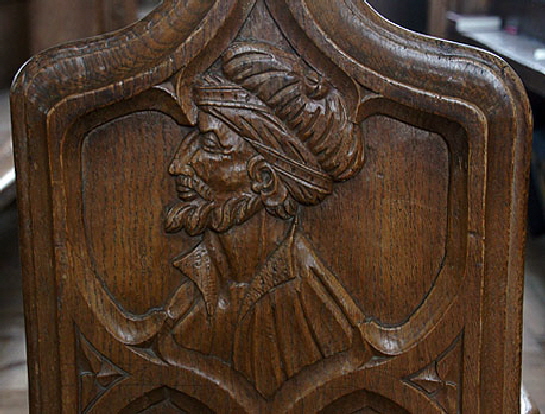 |
||||||||||||||||||||||||||||||||
|
Left: Another favourite. A man is driving a horse with a whip. The man’s demeanour might be best described as “flouncing” - dare I say “camp”? He has over-sized slashed sleeves on his costume and a dressy hat. He has a hint of genitalia or codpiece at his crotch. The horse, incidentally, is also well-endowed! The horse carries sacks. My feeling is that this piece is satirical. Is the carver having a pop at the local prosperous miller or wool merchant? Right: The bench ends here should be a valuable resource for anyone studying the costume of the period. Unfortunately we don’t know the status of any of the characters shown. Right: One of the “villager” carvings and an exceptionally fine one with remarkable detail in the headdress. These carvings had me poring over Diana’s little collection of costume books but none of the pictures looked like this one. There are two endemic problems here. Firstly, most books and websites concentrate overwhelmingly on costumes worn by the rich. This is inevitable since most information will have been gleaned from paintings or dated church memorials. Secondly there is, understandably, far more interest in women’s attire. Disappointed, I reflected a bit. What exactly was I hoping to find in these books? Was it just a name for this man’s hat? A name that probably would have been unknown to the wearer? With a flash of insight I realised that I shouldn’t be looking for these costumes in books. The publishers of such books should be looking at these carvings! So make of them what you will. I think this particular representation is likely to be of someone relatively prosperous - a “professional” we would perhaps call him today. |
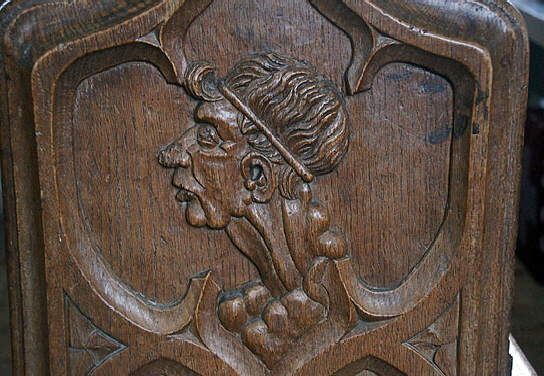 |
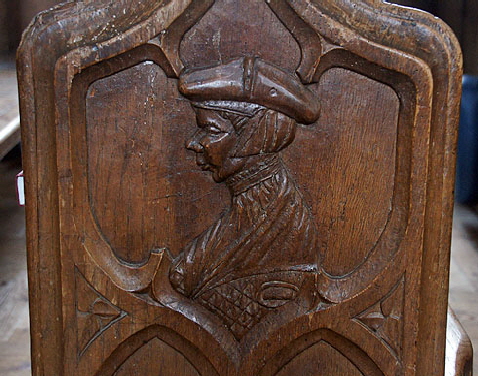 |
||||||||||||
|
Left: This man could be wearing a hat or just a headband. He’s an ugly geezer - look at those ears. I’m always a bit sceptical about the “this was an actual person” school of thought but in the case of these carvings I rather think they were. Right: Right: There is a wealth of invaluable costume detail in this profile of a woman. |
|||||||||||||
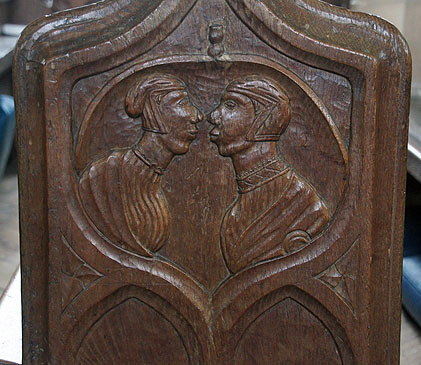 |
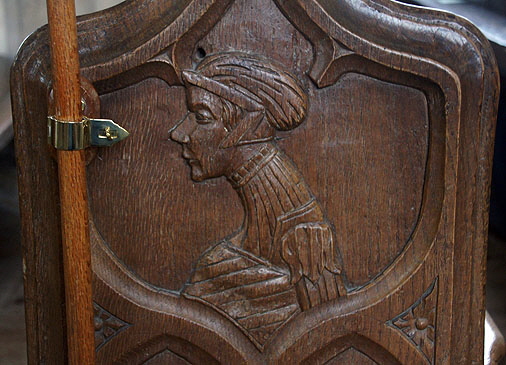 |
||||||||||||
|
Left: Depending on who you believe this is a couple kissing or a couple having a good old row! It looks like a kiss to me and in 2021 I was contacted by Cecilia Giraldi in Italy who is of the opinion that this represents the “Kiss of Peace”. There are several scriptural references. The chasteness of this particular kiss is surely supportive of that notion and we do not have to assume that it represents and man and a woman. Please see the footnote below for more examples sent by Ms Giraldi. Right: More material for the costume student. |
|||||||||||||
|
I am afraid this is only about half of the bench ends at North Cadbury. Not all are very interesting but I admit I am frustrated with myself for not having photographed them all. Are they all by the same man? They do appear to be although the cat, for example, looks a bit different stylistically. Interestingly, there are substantial claims that the bench ends in common with many others in the area were carved at the “Corton Ridge Workshop”. You can buy a CD Rom “book” on this subject by Bob Osborn. I am not going to talk about this because you really should buy his book. If it is true, however, we can make a couple of observations. Firstly, if the faces are of “real” people then they are not likely to be of North Cadbury people. Secondly, it increases the likelihood that the bench ends are the work of more than one man. |
|||||||||||||
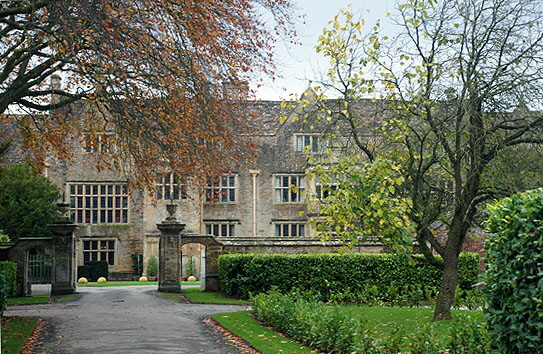 |
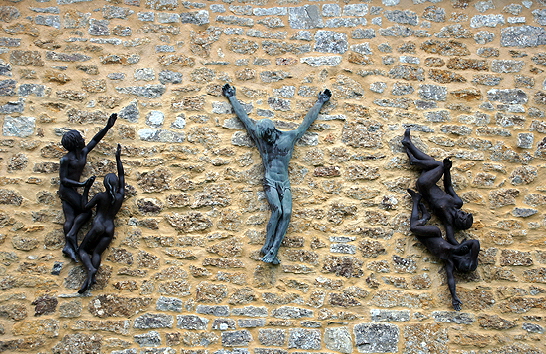 |
||||||||||||
|
Left: North Cadbury Court which is adjacent to the church. This building was built by the Puritan Sir Francis Hastings who died in 1610. It replaced the mediaeval manor house in which Lady Elizabeth lived. Right: This set of sculptures entitled “Redemption” was by local artist John Robinson and are affixed to the stables of North Cadbury Court. They were to replace some fittings that had been damaged in the church during the nineteen-eighties. The church website says coyly that they were “controversial”. Jesus has a modern haircut and no beard so not a bit like his photographs. The couples either side are, horror of horrors, naked. So that’s what the controversy was about, presumably. I think they are rather beautiful and it’s a shame that narrow minds had to be pandered to. Do you like irony? Well, these sculptures are affixed to a building commissioned by a Puritan. That school of thought is still alive and well then. |
|
Footnote - Collegiate Churches |
|
“Collegiate” is one of those words - there are many - that is bandied around in church guides without explanation. You might have thought that the word “college” implies some sort of educational role but you would be wrong. The four essential elements of a collegiate church were: 1. There was more than one ordained priest incumbent. 2. There was a formal endowment to provide subsistence for the clergy. 3. It was not a Cathedral - that is, there was no bishop. 4. They were not monastic communities. Although non-monastic, the colleges perhaps did develop out of early monastic practice. The earliest monastic churches - so called “minsters” - housed monks who served the wider community at a time when the parish system had not been established and many settlements had no place of worship. The great monastic foundations that followed (Cluniac, Cistercian and so on) demanded seclusion from the outside world. The priests serving collegiate churches were not monks. Often they were termed “canons”. They were - confusingly - known as “secular” canons. This did not, of course, imply that they were not religious. It simply meant they were not part of a monastic order. There were monastic canons in some churches and these were known as “regular” canons. Confusing or what? There was a variety of ways in which the clergy could be maintained. At first most endowments were pooled amongst the canons and such men were know as “portioners”. Today we might call them shareholders. Later many canons had their own endowments and they were known as “prebendaries”. One of the clergy would be the rector (that is, the recipient of the tithes) and serve as parish priest. So why have churches with a college of priests? The answer is usually to do with the mediaeval terror of Purgatory. I am going to assume you know what Purgatory was supposed to be but you might be less aware that it has no scriptural foundation whatsoever. There seems to have a long pre-Christian tradition of praying for the dead. This implies that all is not black and white beyond the grave. Christianity picked up this tradition and the concept of an “interim state” where the dead awaited the Last Judgement at which point the elevator took you to the roof garden or to the basement. When you think about it the idea has a certain logic. Only in the twelfth century did the concept arise that Purgatory was a physical place where fire (the Christian Fathers loved fire) would purge you - hence the name - of your inevitable sins. Purgatory became the most useful weapon in the armoury of the mediaeval Roman Catholic cleric. Remission from periods in purgatory could be bought by endowing or helping in the building of churches, paying for “indulgences” (aka rich people bribing the clergy) or by having a lot of masses said for your immortal soul. Needless to say, none of this has any scriptural support either. Rich people were distinctly unthrilled by the notion of Purgatory. A common tactic emerged whereby the rich person in question would endow an extension to a church (most commonly, a new aisle or an extension to an existing aisle) housing a little chapel where clergymen could, in return for an endowment, pray for the immortal souls of the benefactor and his family. It wasn’t long before rich merchants were doing the same thing. Not to be left out, “ordinary” people could club together, form a “gild” and endow their own chapels. These chapels were called “chantry chapels” because masses were chanted. Establishing an Collegiate Church, therefore, could be a very smart move indeed. You got heaps of credit in the Heavenly Bank for your investment and you could then get Purgatory-reducing masses said for you as well. You couldn’t just do this: you had to get a licence from the Pope. Lady Elizabeth obtained such a licence and her motive, it is said, was to give thanks for the safe return of her grandson from the Agincourt Campaign in the Hundred Years War, a somewhat more creditable motivation than most perhaps As we have seen, however, it is unlikely that the college was ever established at North Cadbury. The charmless regime of buying release from Purgatory contributed in no small way to the success of the Reformation. Indeed King Edward VI (Henry VIII’s short-lived successor) banned chantry chapels altogether. This, of course, spelt the end for Collegiate Churches. |
|
Footnote 2 - The Kiss of Peace or “Osculum pacis” |
